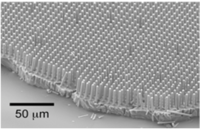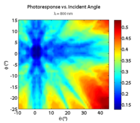Silicon Photocathode Arrays

Fig. 1. Flexible polymer embedded array.
Silicon is a promising photocathode material for photoelectrochemical energy generation because it is earth abundant, has band edges that span the hydrogen redox potential, and is relatively stable in aqueous conditions. We are investigating the use of arrays of VLS grown p-type Si wires as photocathodes in a water-splitting device. There are two advantages to using these highly structured arrays. First, the incident sunlight can still be absorbed along the vertical length of the wire, while the minority charge carriers need to only diffuse a short length to be collected horizontally at a radial junction.

Fig. 2. SEM image of flexible array.
This allows inexpensive materials with short minority carrier diffusion lengths, such as VLS grown Si wires, to effectively capture all photogenerated carriers. Second, the high surface areas of these wire arrays relaxes catalytic activity requirements and opens the door for the use of inexpensive, earth-abundant catalysts.
Our research focuses on: (1) optimizing fabrication techniques for polymer embedded arrays of microwires, (2) understanding the optical and electrical properties of microstructured semiconducting materials using liquid junctions, and (3) investigating earth abundant catalysts for photoelectrochemical hydrogen production.
References
- Brendan M. Kayes, Michael A. Filler, Morgan C. Putnam, Michael D. Kelzenberg, Nathan S. Lewis, and Harry A. Atwater, “Growth of Vertically Aligned Si Wire Arrays Over Large Areas (>1 cm2) with Au and Cu Catalysts”, Appl. Phys. Lett., 2007, 91(10), 103110.
- James R. Maiolo III, Harry A. Atwater, and Nathan S. Lewis, “Macroporous Silicon as a Model for Silicon Wire Array Solar Cells”, J. Phys. Chem. C, 2008, 112(15), 6194.
- Shannon W. Boettcher, Joshua M. Spurgeon, Morgan C. Putnam, Emily L. Warren, Daniel B. Turner-Evans, Michael D. Kelzenberg, James R. Maiolo, Harry A. Atwater, and Nathan S. Lewis, “Energy Conversion Properties of Silicon Wire-Array Photocathodes”, Science, 2009.
- Morgan C. Putnam, Daniel B. Turner-Evans, Michael D. Kelzenberg, Shannon W. Boettcher, Nathan S. Lewis, and Harry A. Atwater, “10 μm Minority-Carrier Diffusion Lengths in Si Wires Synthesized by Cu-Catalyzed Vapor-Liquid-Solid Growth”, App. Phys. Lett., 2009, 95, 163116.
- Shannon W. Boettcher, Emily L. Warren, Morgan C. Putnam, Elizabeth A. Santori, Daniel Turner-Evans, Michael D. Kelzenberg, Michael G. Walter, James R. McKone, Bruce S. Brunschwig, Harry A. Atwater, and Nathan S. Lewis, “Photoelectrochemical Hydrogen Evolution Using Si Microwire Arrays,” J. Am. Chem. Soc., 2011, 133(5), 1216-1219.


